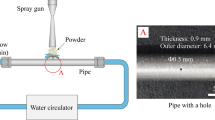Abstract
In this paper, the inner walls of oil pipes were cleaned using cavitation water jet technology after tertiary oil recovery. To improve cleaning efficiency and reduce damage caused by jet impingement, aluminum samples were used instead of oil pipe dirts. Scanning electron microscopy, 3D microscopy, and an electrochemical workstation were used to study the surface morphology, depth of impinging pits, and corrosion resistance of the aluminum samples after impingement with the cavitation water jet. According to the results, there were no obvious changes on the surface of the aluminum samples after impinging at inlet pressures lower than 13 MPa, but if the inlet pressure approached 15 MPa, the area of impinged pits on the surface of aluminum, the depth of impingement pits, and the mass loss of aluminum samples significantly increased, and the corrosion resistance of the oil pipe wall changed less after impingement. This proved that the impinging efficiency of the cavitation water jet was significantly improved and the degree of damage of the oil pipe wall was low near 15 MPa. If the inlet pressure was greater than 15 MPa, the impinging rate obviously increased, but the damage degree of the oil pipe wall was more serious.










Similar content being viewed by others
References
Y.Y. Ren, Present Situation and Future Development of Tertiary Oil Recovery Technology, Chem. Eng. Equip., 2020, 8, p 94–95.
Z.S. Ren and X.M. Wei, Study on Trial Production of Automatic Oil Pipe Cleaning Line for High Pressure Water Jet, Clean. Technol., 2004, 2(6), p 53–58.
S.J. Guo, Z.C. Wang, D.K. Xu and H.J. Zhao, Numerical Simulation and Experimental Study of Oil Tubing Cleaning by Low Pressure Water Jet Nozzles, Contemp. Chem. Ind., 2018, 47(9), p 1972–1977.
K.A. Lawal, V. Vesovic and E.S. Boek, Modeling Permeability Impairment in Porous Media Due to Asphaltene Deposition Under Dynamic Conditions, Energy Fuels, 2011, 25(12), p 5647–5659.
G. Wang and L.F. Wang, Improvement and Application Evaluation of High Temperature Steam Hot Washing and Wax Removal Technology, Clean. World, 2020, 36(1), p 14–15.
Y. Chen, Research on the Tubing Cleaning and Testing Technique of High Pressure Water Jet, Manag. Technol. SME, 2018, 10, p 140–141.
Z. He, J. Bai, Q. Wang and Y. Huang, Visualization Experiment and Numerical Simulation for Cavitating Flow in a Diesel Injector Nozzle, Trans. Chin. Soc. Agric. Mach., 2011, 42(11), p 6–9.
H.T. Cheng and X.S. Shen, Advances in the Application of Hydraulic Cavitation Technology, Food Ind., 2020, 41(6), p 273–278.
X.L. Yuan, X.L. He and K.D. Wang, Numerical Simulation of Effects of Vapor and Liquid Phase Viscosity Coefficients on Cavitation Bubble Collapse Process, Adv. Sci. Technol. Water Resour., 2020, 40(5), p 19–23.
M. Zhang, G.J. Chen, Z.P. Ma, H.X. Li and Y. Li, Growth and Fracture of Ultrasonic Cavitation Bubbles in Thin Layer of Liquid Solder, Weld. Join., 2019, 3, p 6–11.
R.Z. Shi, Z. Tian and Q. Fan, Investigating on Wall Pressure and Cavitation Characteristics of Bending Duct Flow Under Different Area of Outlet, Adv. Eng. Sci. S, 2016, 2, p 13–19.
R.J. Liu, Y.C. Liu and G.H. Qu, The Effects on the Near Rigid Wall of the Cavitation Bubble Collapsing, J. Xinxiang Univ., 2010, 27(3), p 29–31.
S. Fu, Y.C. Li and L.L. Liu, Cavitating Water Jet Formation Techniques and Their Application, Mech. Sci. Technol. Aerosp. Eng., 2006, 25(4), p 491–496.
X.H. Zhao, Y.F. Feng, C.X. Yi and Y. Han, Corrosion Behavior of Tubing Steel 15Cr in Artificial Formation Water Solutions Containing CO2/H2S, Corros. Sci. Prot. Technol., 2016, 28(4), p 325–331.
F.F. Xia, C.Y. Li, C.Y. Ma, Q. Li and H.Y. Xing, Effect of Pulse Current Density on Microstructure and Wear Property of Ni-TiN Nanocoatings Deposited via Pulse Electrodeposition, Appl. Surf. Sci., 2021, 538, p 148139.
C.Y. Ma, D.Q. Zhao and Z.P. Ma, Effects of Duty Cycle and pulse Frequency on Microstructures and Properties of Electrodeposited Ni-Co-SiC Nanocoatings, Ceram. Int., 2020, 46(8), p 12128–12137.
C. Ma, D. Zhao, H. Xia, F. Xia, Z. Ma and T. Williams, Microstructure and Properties of Ni-SiC Nanocomposites Fabricated by Ultrasonic-Assisted Electrodeposition, Int. J. Electrochem. Sci., 2020, 15, p 4015–4031.
X.H. Zheng, M. Wang, H. Song, D. Wu, X.T. Liu and J. Tan, Effect of Ultrasonic Power and Pulse-On Time on the Particle Content and Mechanical Property of Co-Cr3C2 Composite Coatings by Jet Electrodeposition, Surf. Coat. Technol., 2017, 325, p 181–189.
Acknowledgment
This work has been supported by the Heilongjiang Postdoctoral Foundation of China (Granted No. LBH-Z20183), the Heilongjiang Bayi Agricultural University Support Program for San Heng San Zong (Granted Nos. TDJH201803 and TDJH201907), the Scientific Research Starting Foundation for Returnees and Excellent Scholars (Granted No. XDB201804), the Training Programs of Innovation and Entrepreneurship for Undergraduates (Granted No. 201910223020), and the National Key R & D project (Granted No. 2017YFC1601905-04).
Author information
Authors and Affiliations
Corresponding author
Additional information
Publisher's Note
Springer Nature remains neutral with regard to jurisdictional claims in published maps and institutional affiliations.
Rights and permissions
About this article
Cite this article
Yang, Z., Yi, S., Zhao, S. et al. Effects of Different Inlet Pressures on Impingement Characteristics of Aluminum. J. of Materi Eng and Perform 30, 3670–3676 (2021). https://doi.org/10.1007/s11665-021-05741-0
Received:
Revised:
Accepted:
Published:
Issue Date:
DOI: https://doi.org/10.1007/s11665-021-05741-0




